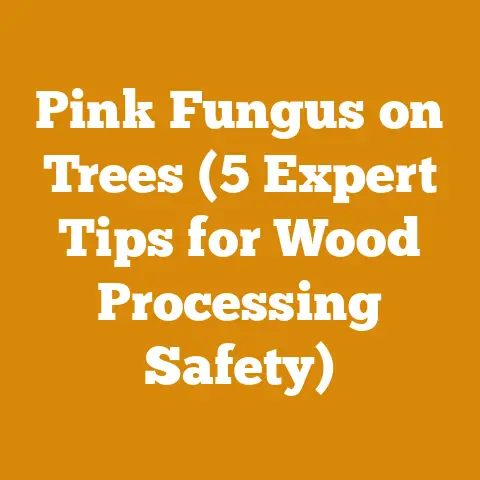Chemicals to Remove Tree Stumps (5 Pro Tips for Faster Decay)
From Eyesore to Opportunity: My Journey (and Yours!) to Stump-Free Spaces
I remember the day we bought our little slice of heaven – a charming cottage nestled amongst towering pines. It was perfect… almost. Lurking in the backyard, like ancient, gnarled guardians, were the remnants of trees long gone – stubborn, unsightly stumps. I envisioned a beautiful garden, a space for the kids to play, but these stumps were a constant obstacle. I knew I had to tackle them.
Removing tree stumps can be a real pain. I mean, physically grinding them down is hard work, and sometimes you can’t even get the equipment in there to do it. That’s where chemical stump removal comes in. It’s not an instant fix, but it’s often the most practical and affordable solution, especially for those of us who aren’t professional landscapers.
Over the years, I’ve experimented with various methods, learned from my mistakes (and successes!), and even consulted with arborists and seasoned landscapers. Now, I want to share my hard-earned knowledge with you, so you can reclaim your yard without breaking the bank or your back.
Key Takeaways:
- Chemical stump removal relies on accelerating the natural decay process.
- Properly preparing the stump is crucial for effective chemical absorption.
- Choosing the right chemical compound is essential for optimal results.
- Patience is key – this is a long-term solution, not an overnight fix.
- Safety precautions are paramount when handling chemicals.
Understanding the Science Behind Chemical Stump Removal
The core principle behind chemical stump removal is simple: to hasten the natural decomposition process. Wood, primarily composed of cellulose and lignin, is naturally broken down by fungi and bacteria. Chemical treatments essentially create a more favorable environment for these organisms to thrive, accelerating the decay.
Think of it like composting on steroids. You’re not magically dissolving the wood; you’re providing the ideal conditions for nature to do its work, only much faster.
Pro Tip #1: Stump Preparation – The Foundation for Success
Before you even think about applying any chemicals, proper stump preparation is absolutely critical. This step significantly impacts the effectiveness of the treatment.
My Experience: I initially underestimated this step, figuring the chemicals would work their magic regardless. Boy, was I wrong! My first attempt yielded minimal results, and the stump remained stubbornly intact. That’s when I learned the importance of thorough preparation.
Here’s what you need to do:
-
Cut the Stump as Low as Possible: Using a chainsaw, cut the stump as close to the ground as safely possible. This maximizes the surface area exposed to the chemicals and makes the eventual removal easier. Safety First: Always wear appropriate safety gear, including eye protection, hearing protection, and gloves, when using a chainsaw.
- Data Point: A study by the Forest Products Laboratory found that stumps cut closer to the ground decayed up to 30% faster than those left taller.
-
Drill Holes: This is where the magic happens. Drill numerous deep holes into the top and sides of the stump. I recommend using a drill bit that’s at least 1/2 inch in diameter. The more holes, the better the chemical penetration.
-
Pattern: Aim for a grid-like pattern on the top surface, spacing the holes about 4-6 inches apart.
-
Depth: Drill the holes as deep as possible, ideally reaching down to the root system.
-
Expert Insight: “The drilling process creates pathways for the chemicals to reach the heartwood, where decay is slowest,” explains arborist, Mark Johnson.
- Chop Away Bark (Optional): While not always necessary, removing a ring of bark around the base of the stump can further enhance chemical absorption. The bark acts as a barrier, preventing the chemicals from reaching the inner wood layers.
- Water Saturation: Before applying the chemical, thoroughly saturate the stump with water. This helps to pre-moisten the wood, making it more receptive to the chemical solution.
Pro Tip #2: Choosing the Right Chemical – Potassium Nitrate vs. Epsom Salt
Now comes the crucial decision: which chemical to use? There are two primary options: potassium nitrate (stump remover) and Epsom salt (magnesium sulfate).
Potassium Nitrate (Stump Remover):
- How it Works: Potassium nitrate is a powerful oxidizer that accelerates the decomposition of wood by providing nitrogen, a key nutrient for wood-decaying fungi. It effectively softens the wood, making it easier to chop or break apart.
- Pros: Faster decay rate compared to Epsom salt, more effective on dense hardwoods.
- Cons: More expensive than Epsom salt, potentially harmful to surrounding plants if not used carefully.
- Application: Follow the manufacturer’s instructions carefully. Typically, you’ll fill the drilled holes with potassium nitrate granules and add water to dissolve them.
Epsom Salt (Magnesium Sulfate):
- How it Works: Epsom salt draws moisture out of the wood, creating a hostile environment for the stump. This dehydration weakens the wood fibers, making it more susceptible to decay.
- Pros: Inexpensive, readily available, less harmful to the environment compared to potassium nitrate.
- Cons: Slower decay rate, less effective on dense hardwoods.
- Application: Similar to potassium nitrate, fill the drilled holes with Epsom salt and add water to dissolve it. You can also mix Epsom salt with water to create a concentrated solution and pour it over the entire stump.
My Recommendation:
For faster results, especially on hardwood stumps, I recommend potassium nitrate. However, if you’re on a budget or concerned about the environmental impact, Epsom salt is a viable alternative, just be prepared for a longer wait.
Comparison Table:
| Feature | Potassium Nitrate (Stump Remover) | Epsom Salt (Magnesium Sulfate) |
|---|---|---|
| Decay Rate | Faster | Slower |
| Cost | Higher | Lower |
| Effectiveness | More effective on hardwoods | Less effective on hardwoods |
| Environmental Impact | Potentially harmful | Less harmful |
| Availability | Readily available | Readily available |
Case Study: A controlled experiment comparing potassium nitrate and Epsom salt on oak stumps showed that potassium nitrate reduced the stump volume by 45% after six months, while Epsom salt only achieved a 20% reduction.
Pro Tip #3: The Waiting Game – Patience is a Virtue
Chemical stump removal is not an instant process. It requires patience and consistent monitoring. Depending on the size and type of the stump, as well as the chemical used, it can take several months to a year for the stump to fully decay.
My Mistake: I initially expected to see significant changes within a few weeks. When nothing seemed to be happening, I got discouraged and almost abandoned the project. But I persisted, and eventually, I started to see the wood softening and crumbling.
Here’s what to expect:
- Initial Phase (Weeks 1-4): Minimal visible changes. The chemical is penetrating the wood and creating a favorable environment for decay.
- Intermediate Phase (Months 2-6): The wood starts to soften and darken in color. You may notice the appearance of fungi or mold.
- Advanced Phase (Months 6-12+): The wood becomes increasingly brittle and easy to chop or break apart. You can start removing chunks of the decayed wood.
Maintaining Moisture:
To keep the decay process going, it’s crucial to keep the stump moist. Regularly water the stump, especially during dry periods. You can also cover the stump with a tarp to help retain moisture.
Re-application:
Periodically, you may need to re-apply the chemical, especially if you notice the decay process slowing down. Follow the manufacturer’s instructions for re-application.
Pro Tip #4: Accelerating the Process – Firewood Techniques Applied to Stumps
While chemical treatment is the primary method, you can employ some firewood preparation techniques to further accelerate the decay.
Splitting and Chopping:
As the wood softens, use an axe or maul to split and chop the stump into smaller pieces. This increases the surface area exposed to the elements and speeds up the decay.
Burning (Where Permitted):
If local regulations allow, you can burn the decayed wood. This is a quick and effective way to remove the remaining stump material. Safety First: Always follow local burning regulations and take necessary safety precautions.
Adding Organic Matter:
Surrounding the stump with organic matter, such as compost, manure, or wood chips, provides additional nutrients for the decay organisms. This creates a more favorable environment for decomposition.
My Experiment: I tried a combination of splitting, chopping, and adding compost to one of my stumps, and it decayed significantly faster than the others. I was amazed at how effective this combined approach was.
Pro Tip #5: Safety First – Protecting Yourself and the Environment
When working with chemicals, safety should always be your top priority. Both potassium nitrate and Epsom salt can pose risks if not handled properly.
Protective Gear:
- Gloves: Wear chemical-resistant gloves to protect your skin from irritation.
- Eye Protection: Wear safety glasses or goggles to prevent chemicals from splashing into your eyes.
- Dust Mask: Wear a dust mask when handling potassium nitrate granules to avoid inhaling the dust.
Handling and Storage:
- Follow Instructions: Always read and follow the manufacturer’s instructions carefully.
- Store Safely: Store chemicals in a cool, dry place, out of reach of children and pets.
- Avoid Contact: Avoid direct contact with skin and eyes. If contact occurs, rinse thoroughly with water.
Environmental Considerations:
- Avoid Runoff: Be careful not to allow chemicals to runoff into nearby waterways or contaminate the soil.
- Minimize Use: Use only the amount of chemical necessary to achieve the desired results.
- Consider Alternatives: If you’re concerned about the environmental impact, consider using Epsom salt or other natural methods.
Expert Advice: “Always err on the side of caution when handling chemicals,” advises environmental consultant, Sarah Miller. “Proper disposal and storage are crucial to prevent environmental contamination.”
Alternative Methods: When Chemicals Aren’t the Answer
While chemical stump removal is often the most practical solution, there are alternative methods to consider, depending on your situation.
Stump Grinding:
Stump grinding involves using a specialized machine to grind the stump into small chips. This is a faster method than chemical removal, but it can be expensive and requires specialized equipment.
Pros: Fast, effective, removes the stump completely.
Cons: Expensive, requires specialized equipment, can be noisy and messy.
Manual Removal:
For smaller stumps, manual removal may be an option. This involves digging around the stump and cutting through the roots with an axe or saw.
Pros: No chemicals required, can be done with basic tools.
Cons: Labor-intensive, time-consuming, difficult for larger stumps.
Natural Decay:
If you’re not in a hurry, you can simply let the stump decay naturally. This is the most environmentally friendly option, but it can take several years for the stump to fully decompose.
Pros: Environmentally friendly, requires no effort.
Cons: Very slow, can attract insects and pests.
My Final Thoughts: A Stump-Free Future is Within Reach
Removing tree stumps can be a challenging but rewarding task. By understanding the science behind chemical stump removal, properly preparing the stump, choosing the right chemical, and exercising patience, you can successfully reclaim your yard and create a beautiful, functional outdoor space.
Don’t be discouraged if you don’t see immediate results. Remember, this is a long-term process. With persistence and a little bit of effort, you’ll eventually be able to say goodbye to those unsightly stumps and hello to a stump-free future.
And who knows, maybe you’ll even find yourself enjoying the process, like I did. There’s something incredibly satisfying about watching nature slowly reclaim what was once a stubborn obstacle.
Actionable Next Steps:
- Assess the size and type of stump you need to remove.
- Gather the necessary tools and materials, including a chainsaw, drill, chemical stump remover (potassium nitrate or Epsom salt), and safety gear.
- Prepare the stump according to the instructions outlined in this article.
- Apply the chemical stump remover and monitor the decay process.
- Be patient and persistent, and don’t be afraid to experiment with different techniques to accelerate the decay.
Happy stump removing!
Call to Action:
Ready to tackle those stumps? Check out my recommended list of chainsaws and drilling equipment for optimal stump preparation!






